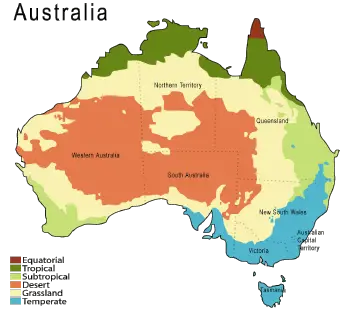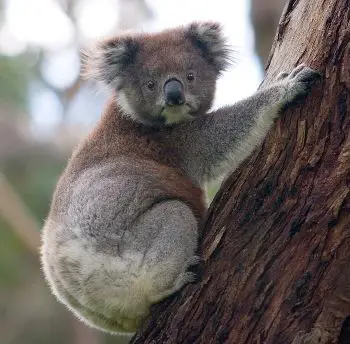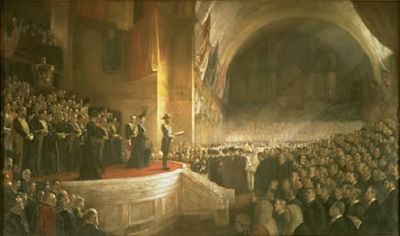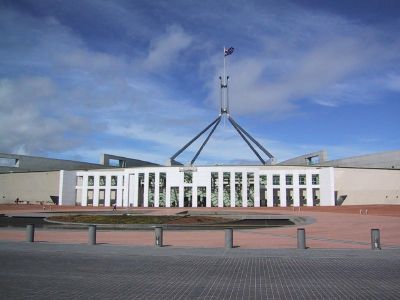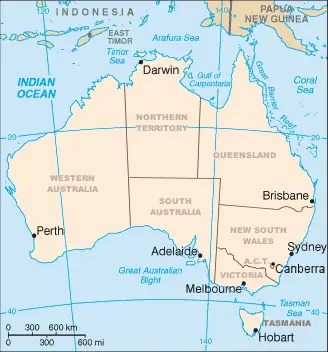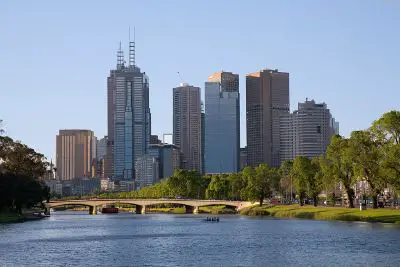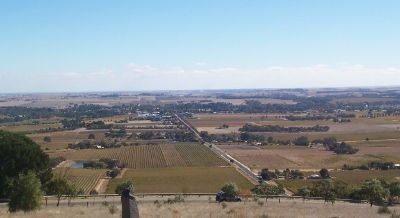Difference between revisions of "Australia" - New World Encyclopedia
Mike Butler (talk | contribs) (Australia - infobox) |
Rosie Tanabe (talk | contribs) |
||
| (115 intermediate revisions by 14 users not shown) | |||
| Line 1: | Line 1: | ||
| − | {{ | + | {{2Copyedited}}{{Ebcompleted}}{{Copyedited}}{{Paid}}{{Approved}}{{Images OK}}{{submitted}}{{status}} |
| − | {{Infobox | + | |
| − | + | {{Infobox country | |
| − | common_name =Australia| | + | |native_name = |
| − | image_flag =Flag of Australia.svg | + | |conventional_long_name = Commonwealth of Australia |
| − | + | |common_name = Australia | |
| − | image_coat =Australia_coa.png| | + | |image_flag = Flag of Australia.svg |
| − | image_map =AustraliaWorldMap.png| | + | |image_coat =Australia_coa.png |
| − | + | |image_map =AustraliaWorldMap.png | |
| − | + | |map_width = 220px | |
| − | + | |national_anthem = "[[Advance Australia Fair]]"<ref>Australia also has a [[royal anthem]], "[[God Save the Queen|God Save the Queen (or King)]]," which is played in the presence of a member of the [[House of Windsor|Royal family]] when they are in Australia. In all other appropriate contexts, the [[national anthem]] of Australia, "[[Advance Australia Fair]]," is played. See [https://www.pmc.gov.au/government/australian-national-anthem Australian National Anthem] Retrieved November 4, 2022; National Library of Australia, ''Parliamentary Handbook of the Commonwealth of Australia'' (University of Michigan Library, 2010).</ref> | |
| − | capital =[[Canberra]] | + | |official_languages = None |
| − | + | |languages_type = [[National language]] | |
| − | largest_city =[[Sydney]]| | + | |languages = [[English language|English]] ''([[de facto]])''<ref name=language>[https://web.archive.org/web/20081220020910/http://www.immi.gov.au/media/publications/multicultural/confer/04/speech18b.htm Pluralist Nations: Pluralist Language Policies?] Global Cultural Diversity Conference Proceedings, Sydney, 1995. Department of Immigration and Citizenship. Retrieved November 4, 2022. "English has no de jure status but it is so entrenched as the common language that it is de facto the official language as well as the national language."</ref> |
| − | government_type=[[ | + | |capital = [[Canberra]] |
| − | + | |largest_city = [[Sydney]] | |
| − | + | |government_type = [[Federalism|Federal]] [[parliamentary system|parliamentary democracy]] and [[constitutional monarchy]] | |
| − | area_rank=6th| | + | |leader_title1 = [[Monarchy of Australia|Monarch]] |
| − | + | |leader_title2 = [[Governor-General of Australia|Governor-General]] | |
| − | + | |leader_title3 = [[Prime Minister of Australia|Prime Minister]] | |
| − | + | |leader_name1 = [[Charles III]] | |
| − | + | |leader_name2 = [[David Hurley]] | |
| − | + | |leader_name3 = [[Anthony Albanese]] | |
| − | + | |legislature = [[Parliament of Australia|Parliament]] | |
| − | population_estimate_rank = | + | |upper_house = [[Senate of Australia|Senate]] |
| − | + | |lower_house = [[House of Representatives of Australia|House of Representatives]] | |
| − | population_census_year = | + | |area_rank = 6th |
| − | + | |area_km2 = 7617930 | |
| − | + | |percent_water = | |
| − | population_density_rank = | + | |population_estimate = 26,068,449<ref>[https://www.abs.gov.au/ausstats/abs@.nsf/94713ad445ff1425ca25682000192af2/1647509ef7e25faaca2568a900154b63?OpenDocument Population clock] ''Australian Bureau of Statistics''. Retrieved November 4, 2022. </ref> |
| − | + | |population_estimate_year = {{CURRENTYEAR}} | |
| − | + | | population_census = 25,890,773<ref>[https://www.abs.gov.au/statistics/people/population/national-state-and-territory-population/mar-2022 National, state and territory population] ''Australian Bureau of Statistics''. Retrieved November 4, 2022.</ref> | |
| − | + | |population_estimate_rank = 53rd | |
| − | currency=[[Australian dollar | + | |population_census_year = 2021 |
| − | currency_code=AUD| | + | |population_density_km2 = 3.4 |
| − | time_zone=[[ | + | |population_density_rank = 192nd |
| − | utc_offset=+ | + | |sovereignty_type = Independence |
| − | time_zone_DST=[[ | + | |sovereignty_note = from the [[United Kingdom]] |
| − | utc_offset_DST=+ | + | |established_event1 = [[Constitution of Australia|Constitution]] |
| − | cctld= [[.au]] | | + | |established_event2 = [[Statute of Westminster 1931|Statute of Westminster]] |
| − | calling_code=61| | + | |established_event3 = [[Statute of Westminster Adoption Act 1942|Statute of Westminster Adoption Act]] |
| − | + | |established_event4 = [[Australia Act 1986|Australia Act]] | |
| − | + | |established_date1 = January 1, 1901 | |
| − | + | |established_date2 = December 11, 1931 | |
| − | + | |established_date3 = October 1942 9, (with effect from 3 September 1939) | |
| − | + | |established_date4 = March 3, 1986 | |
| − | + | |currency = [[Australian dollar]] | |
| − | + | |currency_code = AUD | |
| − | + | |time_zone = [[Time in Australia|various]]<ref name="time">There are minor variations from these three time zones.</ref> | |
| − | + | |utc_offset = +8 to +10.5 | |
| − | + | |time_zone_DST = [[Time in Australia|various]]<ref name="time"/> | |
| + | |utc_offset_DST = +8 to +11.5 | ||
| + | |demonym = [[Australians|Australian]], [[Aussie]]<ref>Arthur Delbridge, ''The Macquarie Dictionary'' (Macquarie Library, 1982, ISBN 978-0949757005). </ref><ref>Collins, ''Collins English Dictionary'' (Collins, 2011, ISBN 978-0007437863).</ref> | ||
| + | |drives_on = left | ||
| + | |cctld = [[.au]] | ||
| + | |calling_code = [[+61]] | ||
| + | |ISO_3166-1_alpha2 = AU | ||
| + | |ISO_3166-1_alpha3 = AUS | ||
| + | |ISO_3166-1_numeric = 036 | ||
| + | |sport_code = AUS | ||
| + | |vehicle_code = AUS | ||
| + | | GDP_nominal = {{increase}} {{nowrap|$1.748 trillion<ref name=IMF>[https://www.imf.org/en/Publications/WEO/weo-database/2022/April Report for Selected Countries and Subjects: April 2022] ''International Monetary Fund'', April 2022. Retrieved November 4, 2022.</ref>}} | ||
| + | | GDP_nominal_year = 2022 | ||
| + | | GDP_nominal_rank = 13th | ||
| + | | GDP_nominal_per_capita = {{increase}} $67,464<ref name=IMF /> | ||
| + | | GDP_nominal_per_capita_rank = 11th | ||
| + | | Gini = 32.5<ref>[https://stats.oecd.org/Index.aspx?DataSetCode=IDD Income Distribution Database] ''Organisation for Economic Co-operation and Development'', December 9, 2021. Retrieved November 4, 2022. </ref> | ||
| + | | Gini_year = 2018 | ||
| + | | Gini_change = decrease <!--increase/decrease/steady—> | ||
| + | | Gini_ref = | ||
| + | | Gini_rank = 16th | ||
| + | | HDI = 0.951<ref>[https://hdr.undp.org/system/files/documents/global-report-document/hdr2021-22pdf_1.pdf Human Development Report 2021/2022] ''United Nations Development Programme'', September 8, 2022. Retrieved November 4, 2022.</ref><!--number only—> | ||
| + | | HDI_year = 2021<!-- Please use the year to which the data refers, not the publication year—> | ||
| + | | HDI_change = increase<!--increase/decrease/steady—> | ||
| + | | HDI_ref = | ||
| + | | HDI_rank = 5th | ||
}} | }} | ||
| − | + | The '''Commonwealth of Australia''' is a nation strategically located between the [[Indian Ocean|Indian]] and [[Pacific Ocean]]s with strong cultural and political ties to [[North America]] and [[Europe]]. The world's sixth largest country and an island continent occupied by a single nation, its name is derived from the Latin ''Australis,'' meaning "of the South." It is sometimes referred to as the "land down under," a reference to its long distance from its mother country, Britain. | |
| − | The '''Commonwealth of Australia''' is a | + | {{toc}} |
| + | Initially a site for [[England|English]] [[penal colony|penal colonies]] in the eighteenth and nineteenth centuries as well as a base of British economic exploitation of the area, Australia grew to become a constitutional [[democracy]] whose people built a nation free of the limitations prevalent in crowded England. Australia has developed a robust economy and high living standard. Although arid throughout much of its surface, part of its prosperity came from its extensive [[mineral]] resources. Once considered geographically isolated, Australia today benefits from its proximity to both East Asia and South Asia, and overall plays an increasingly important role in the Asia-Pacific. Within [[Oceania]] itself, Australia exercises crucial leadership, both as a benefactor to island nations and through its ability to project military power. | ||
| − | + | ==Geography== | |
| + | Australia, pronounced “ors-trial-ya” by the country's inhabitants, is a large landmass on the Indo-Australian Plate, slightly smaller than the contiguous 48 states of the [[United States of America|United States]]. It is surrounded by the [[Indian ocean|Indian]] and [[Pacific Ocean]]s, and the Tasman Sea. Australia is separated from Asia by the Arafura and Timor seas. Neighboring countries include [[Indonesia]], [[East Timor]], [[Irian Jaya]] and [[Papua New Guinea]] to the north; the [[Solomon Islands]], [[Vanuatu]] and the [[France|French]] dependency of [[New Caledonia]] to the northeast; with [[New Zealand]] to the southeast. | ||
| − | + | Australia—owing to its size and isolation—is often dubbed the "island continent"[139] and is sometimes considered the world's largest island. Australia has 34,218 km (21,262 mi) of coastline (excluding all offshore islands). | |
| − | + | The [[Great Barrier Reef]], the world's largest coral reef, lies a short distance off the northeast coast and extends for 2,000 kilometers (1,240 miles). The world's largest monolith, [[Mount Augustus]], is located in Western Australia. At 2,228 meters (7,350 feet), Mount Kosciuszko on the Great Dividing Range is the highest mountain on the mainland, although Mawson Peak on the remote Heard Island and McDonald Island is taller at 2,745 meters (9,058 feet). | |
| − | The | ||
| − | |||
| − | |||
| − | + | Tectonic uplift of mountain ranges or clashes between [[tectonic plates]] occurred in Australia's early history, when it was still a part of [[Gondwana]]. [[Erosion]] has heavily weathered Australia's surface, making it one of the flattest countries in the world. | |
| − | + | Much of Australia is desert or semi-arid. Only the southeast and southwest corners of the continent have a temperate climate and moderately fertile soil. The north, with a tropical climate, has [[rainforest]], [[woodland]], [[grassland]] and [[desert]]. Climate is influenced by ocean currents, including the [[El Niño]] southern oscillation, which brings periodic [[drought]], and the seasonal tropical low pressure system that produces [[cyclone]]s in northern Australia. | |
| − | + | [[Image:Australia-climate-map MJC01.png|right|thumb|350px|Climatic zones in Australia.]] | |
| − | + | [[Image:Koala climbing tree.jpg|right|thumb|350px|The [[Koala]] and the ''[[Eucalyptus]]'' make an iconic pair of Australian flora and fauna.]] | |
| − | + | ||
| − | + | Rainfall is variable, with frequent droughts lasting several seasons. Dust storms can blanket a region or even several states. | |
| − | [[Image: | ||
| − | The | ||
| − | The [[ | + | The [[Great Artesian Basin]], an important source of water for people and cattle in the parched outback region, is the world's largest and deepest fresh water basin. |
| − | |||
| − | |||
| − | + | Natural hazards include cyclones along the northern coasts, severe [[thunderstorm]]s, droughts and occasional [[flood]]s as well as frequent [[bushfire]]s. | |
| − | + | Natural resources include: [[bauxite]], [[coal]], [[iron ore]], [[copper]], [[tin]], [[gold]], [[silver]], [[uranium]], [[nickel]], [[tungsten]], mineral sands, [[lead]], [[zinc]], [[diamond]]s, [[natural gas]] and [[petroleum]]. | |
| − | + | Arable land constitutes six percent of land use, permanent pastures make up 54 percent, [[forest]]s and [[woodland]]s cover 19 percent. | |
| − | [[ | ||
| − | The | + | The capital city is [[Canberra]], although the population is concentrated in the large coastal cities of [[Sydney]], [[Melbourne]], [[Brisbane]], Perth, and [[Adelaide]]. |
| − | There | + | Most Australian woody plant species are evergreen and many are adapted to [[fire]] and [[drought]], including many [[eucalypt]]s and acacias. There is a rich variety of endemic legume species that thrive in nutrient-poor soils because of their [[symbiosis]] with Rhizobia [[bacteria]] and [[Fungus|fungi]]. Well-known [[fauna]] include the [[platypus]] and [[echidna]]; a host of [[marsupial]]s, including the [[koala]], [[kangaroo]], [[wombat]]; and [[bird]]s such as the [[emu]], and [[kookaburra]]. The dingo was introduced by Austronesian people that traded with indigenous Australians around 4000 <small>B.C.E.</small> Many plant and animal [[species]] became extinct after human settlement, including the Tasmanian [[Tiger]]. |
| − | |||
| − | + | ==History== | |
| + | The first Australians, ancestors of the current indigenous Australians, arrived via land bridges and short sea-crossings from Southeast Asia between 42,000 and 48,000 years ago. Most were [[hunter-gatherer]]s, with an oral culture and spiritual values based on reverence for the land and a belief in a mythological “dreamtime.” The Torres Strait Islanders, ethnically [[Melanesia]]n, possess cultural practices that are different from the [[Aborigine]]s. | ||
| − | + | Dutch navigator [[Willem Jansz]] sighted Cape York Peninsula in 1606, becoming the first European to do so. The Dutch charted the western and northern coastlines of what they called New Holland in the seventeenth century, but made no attempt at settlement. | |
| + | [[Image:Endeavour replica in Cooktown harbour.jpg|400px|right|thumb|Lieutenant [[James Cook]] charted the East coast of Australia on HM Bark ''Endeavour'', claiming the land for [[United Kingdom|Britain]] in 1770. This replica was built in Fremantle, Western Australia in 1988; photographed in Cooktown harbour where Cook spent 7 weeks.]] | ||
| + | [[Image:Tom roberts big picture.jpg|thumb|400px|The opening of the Parliament of Australia in 1901]] | ||
| + | [[Image:Anzac1.JPG|right|thumb|300px|The ''Last Post'' is played at an ANZAC Day ceremony in Port Melbourne, Victoria, on April 25, 2005. Ceremonies such as this are held in virtually every suburb and town in Australia.]] | ||
| + | In 1770, James Cook sailed along and mapped the east coast of Australia, which he named New South Wales and claimed for Britain. This led to the establishment of a penal colony there. The transportation of convicts to Australia was phased out between 1840 and 1864. | ||
| − | The | + | The British Crown Colony of New South Wales started with the establishment of a settlement at Port Jackson by Captain Arthur Phillip on January 26, 1788. This date was to become Australia's national day, Australia Day. |
| − | + | Van Diemen's Land, now known as [[Tasmania]], was settled in 1803. The United Kingdom formally claimed the [[Western Australia|western part of Australia]] in 1829. Separate colonies were created from parts of [[New South Wales]]: [[South Australia]] in 1836, [[Victoria (Australia)|Victoria]] in 1851, and [[Queensland]] in 1859. The [[Northern Territory]] was founded in 1863 as part of the Province of South Australia. | |
| − | + | The indigenous Australian population, estimated at about 350,000 at the time of European settlement, declined steeply for 150 years following settlement, because of infectious disease, forced re-settlement and cultural disintegration. The treatment of indigenous people is hotly debated within Australia. After the Australian referendum in 1967, the federal government gained the power to implement policies and make laws with respect to Aborigines. Traditional ownership of land—native title—was not recognized until the High Court of Australia case ''Mabo v Queensland (No. 2)'' overturned the notion of Australia as ''terra nullius'' at the time of European occupation. | |
| − | |||
| − | |||
| − | |||
| − | |||
| − | + | A gold rush began in the early 1850s, and the Eureka Stockade rebellion in 1854 was an early expression of nationalist sentiment. Between 1855 and 1890, the six colonies individually gained responsible government. | |
| − | Australia | + | On January 1, 1901, the colonies federated and the Commonwealth of Australia was born as a Dominion of the British Empire. The Australian Capital Territory (ACT) was formed in 1911 to provide a location for the federal capital of [[Canberra]] ([[Melbourne]] was the capital from 1901 to 1927). |
| − | + | Australia willingly participated in [[World War I]] in which 59,330 Australians lost their lives. Many Australians regard the defeat of the Australian and New Zealand Army Corps (ANZACs) at the Battle of [[Gallipoli]] as the birth of the nation. It was Australia's first major military action. The Kokoda Track Campaign is regarded by many as a nation-defining battle from [[World War II]]. A total of 40,400 Australians died in that war. Seventeen thousand served in the [[Korean War]]. | |
| − | |||
| − | + | The Statute of Westminster (1931) formally ended most constitutional links between Australia and the United Kingdom, but Australia did not adopt the statute until 1942. The shock of the United Kingdom's defeat in Asia in 1942 and the threat of Japanese invasion caused Australia to turn to the [[United States of America|United States]] as a new ally and protector. From 1951, Australia has been a formal military ally of the U.S. under the auspices of the ANZUS treaty. After World War II, Australia encouraged mass immigration from Europe. Beginning in the 1970s and the abolition of a White Australia policy, immigration from Asia and other parts of the world was encouraged. The final constitutional ties between Australia and the United Kingdom ended in 1986 with the passing of the Australia Act 1986, ending judicial appeals to the United Kingdom Privy Council. Australian voters rejected a move to become a republic in 1999 by a 55 percent majority. | |
| − | + | ==Politics== | |
| + | [[Image:NewParliamentHouseInCanberra.jpg|thumb|right|400px|New Parliament House in Canberra was opened in 1988, replacing the Old Parliament House in Canberra. The provisional Parliament House building opened in 1927.]] | ||
| + | The Commonwealth of Australia is a constitutional monarchy and has a parliamentary system of government. [[Charles III]] is the King of Australia, and is represented by the Governor-General of Australia, at federal level, and by the governors at state level. | ||
| − | + | The parliament, or legislative branch of government, consists of an upper house, or senate, of 76 senators, and a lower house, or House of Representatives, of 150 members. Members of the lower house are elected from single-member constituencies, commonly known as “electorates,” allocated to states on the basis of population. Elections for both chambers are held every three years. The party with majority support in the House of Representatives forms government, with its leader becoming prime minister. | |
| − | + | [[Image:Map of Australia.png|thumb|350px|States and territories of Australia]] | |
| + | The executive comprises the King, represented by the governor-general, the prime minister, and a cabinet nominated by the Prime Minister. | ||
| − | + | The judiciary, the third branch of government, consists of the High Court, other federal courts and state courts, all of which became formally independent of the Judicial Committee of the Privy Council in London when the ''Australia Act'' was passed in 1986. The legal system is based on English common law. | |
| − | + | ||
| + | There are three main political parties: the Australian Labor Party, the Australian Liberal Party and the National Party. Independent members and several minor parties—including the Greens, Family First and the Democrats—have achieved representation mostly in the upper house. | ||
| − | + | Australia consists of six states: [[New South Wales]], [[Queensland]], [[South Australia]], [[Tasmania]], [[Victoria (Australia)|Victoria]], and [[Western Australia]]. Two major mainland territories are the [[Northern Territory]] and the [[Australian Capital Territory]]. The state parliaments control hospitals, education, police, the judiciary, roads, public transport and local government. Each state and territory has its own parliament. | |
| − | + | The federal government administers a separate area within New South Wales, the Jervis Bay Territory, as a naval base and sea port for the national capital. External territories include: [[Norfolk Island]], [[Christmas Island]], the [[Cocos (Keeling) Islands]], and the largely uninhabited Ashmore and Cartier Islands, Coral Sea Islands, Heard Island, and McDonald Islands, and the Australian Antarctic Territory. | |
| − | + | Australia's foreign relations have been driven by a close association with the [[United States of America|United States]], through the ANZUS pact and by a desire to develop relationships with Asia and the Pacific, particularly through the Association of Southeast Asian Nations (or ASEAN) and the Pacific Islands Forum. Australia is a member of the Commonwealth of Nations. Much of Australia's diplomatic energy is focused on international trade liberalization. It is a founding member of the [[United Nations]], and extends aid to 60 countries. | |
| − | |||
| − | |||
| − | |||
| − | + | Australia's armed forces—the Australian Defence Force—comprise the Royal Australian Navy, the Australian Army, and the Royal Australian Air Force. All branches of the ADF have been involved in UN and regional peacekeeping, most recently in [[East Timor]], the [[Solomon Islands]] and [[Sudan]], disaster relief, and armed conflict, including the 2003 invasion of [[Iraq]]. The forces, while numerically small compared to some in the region, consist of volunteers and are held in high regard as a well-trained force equipped with modern weapons. | |
==Economy== | ==Economy== | ||
| − | + | [[Image:Melbourne yarra afternoon.jpg|400px|thumb|right|[[Melbourne]] is the second largest city in Australia]] | |
| − | [[Image:Melbourne yarra afternoon.jpg| | + | |
| − | Australia has a prosperous, Western-style | + | Australia has a prosperous, Western-style mixed economy, with a per capita gross domestic product (GDP) slightly higher than those of the UK, Germany, and France. In recent years, the Australian economy has been resilient in the face of global economic downturn. Rising output in the domestic economy has been offsetting the global slump, and business and consumer confidence remains robust. |
| − | + | The Australian economy has not suffered a recession since the early 1990s. The service sector, including tourism, education, and financial services, comprises the majority of GDP. Agriculture and natural resources comprise small amounts, but contribute substantially to Australia's export performance. | |
| − | + | Australia's largest export markets include [[Japan]], [[People's Republic of China]], the [[United States]], [[South Korea]], and [[New Zealand]]. Export commodities include [[coal]], [[gold]], [[meat]], [[wool]], [[alumina]], [[iron ore]], [[wheat]], [[machinery]] and transport equipment. Import commodities include machinery and transport equipment, [[computer]]s and office machines, [[telecommunication]] equipment and parts; crude [[oil]] and [[petroleum]] products. Partners are the U.S., [[China]], Japan, [[Germany]], [[Singapore]], and the United Kingdom. | |
==Demographics== | ==Demographics== | ||
| − | + | [[Image:Sydney_opera_house_and_skyline.jpg|thumb|400px|right|Most Australians live in urban areas; Sydney is the most populous city in Australia. The trend towards [[urbanization]] is also stronger in Australia than many other parts of the world]] | |
| − | [[Image:Sydney_opera_house_and_skyline.jpg|thumb| | ||
| − | Most | + | Most Australians are descended from nineteenth and twentieth-century immigrants from [[Great Britain]] and [[Ireland]]. Australia's population has quadrupled since the end of [[World War I]], spurred by an ambitious immigration program. A policy of multiculturalism has been established to promote racial harmony. |
| − | + | There is a growing self-declared indigenous population—including [[Torres Strait Islands|Torres Strait Islanders]], who are of [[Melanesia]]n descent. [[Indigenous Australians]] have higher rates of imprisonment and unemployment, lower levels of education. and shorter life expectancies. Perceived racial inequality is an ongoing political and human rights issue for Australians. | |
| − | [[Image:Tanunda.jpg| | + | [[Image:Tanunda.jpg|right|thumb|400px|Fewer than 15 percent of Australians live in rural areas. This picture shows the [[Barossa Valley]] wine-producing region of [[South Australia]].]] |
| − | + | The population is aging, with more retirees and fewer people of working age. A large number of Australians live outside their home country. | |
| − | + | English is the official language. Australian English is the only language spoken in the home for around 80 percent of the population. Other languages include Chinese, Italian, and Greek. Many immigrants are bilingual. There were between 200 and 300 Australian [[aborigine|Aboriginal]] languages at the time of first European contact. Only 70 of these languages have survived, and all but 20 are now endangered. An indigenous language remains the main language for a very small minority of people. Australia has a sign language known as [[Auslan]]. | |
| − | Australia has no [[ | + | Australia has no state [[religion]]. Section 116 of the Australian Constitution prohibits the federal government from making any law to establish any religion, impose any religious observance, or prohibit the free exercise of any religion.<ref>[http://classic.austlii.edu.au/au/legis/cth/consol_act/coaca430/s116.html Commonwealth of Australia Constitution Act - Sect 116] ''Commonwealth Consolidated Acts''. Retrieved November 4, 2022.</ref> |
| − | School attendance is compulsory | + | School attendance is compulsory between the ages of six and 15 years (16 years in [[South Australia]] and [[Tasmania]], and 17 years in [[Western Australia]]), contributing to an adult literacy rate of 99 percent. Government grants have helped establish and fund Australia's 38 [[university|universities]]. Several private universities exist. There is a state-based system of vocational training [[college|colleges]], known as Technical and Further Education Institutes, and trades conduct [[apprenticeship]]s. |
==Culture== | ==Culture== | ||
| − | + | [[Image:Golden Summer Eaglemont Arthur Streeton.jpg|right|thumb|400px|''Golden Summer, Eaglemont'' Eaglemont, Victoria by [[Arthur Streeton]] (1889) is an early example of the rich tradition of Australian [[landscape painting]].]] | |
| − | [[Image:Golden Summer Eaglemont Arthur Streeton.jpg|right|thumb| | + | |
| − | The | + | The culture until the mid-twentieth century was Anglo-Celtic, although distinctive Australian features had been evolving from the [[environment]] and Australian [[Aborigine]] culture. American popular culture, particularly [[television]] and [[cinema]], has had a heavy influence over the past 50 years, as has large-scale immigration from non-English-speaking countries, and Australia's Asian neighbors. The vigor and originality of the arts in Australia—[[film]]s, [[opera]], [[music]], [[painting]], [[theater]], [[dance]], and [[craft]]s—are achieving international recognition. |
| + | |||
| + | Australia has a long history of [[visual arts]], starting with the cave and bark paintings of its indigenous peoples. From the time of [[Europe]]an settlement, a common theme in Australian art has been its landscape. The traditions of indigenous Australians are transmitted orally. Australian Aboriginal music, dance and Australian Aboriginal art influence contemporary Australian visual and performing arts. Albert Namatjira is a well-known Aboriginal painter. Many [[ballet]] and theater companies receive funding through the federal government's Council for the Arts. There is a [[symphony]] [[orchestra]] in each capital city, and a national opera company, Opera Australia, first made prominent by the renowned diva Dame [[Joan Sutherland]]. Australian music includes [[classical]], [[jazz]], and many [[popular music]] genres. | ||
| − | + | Australian [[literature]] has also been influenced by the landscape; the works of writers [[Banjo Paterson]] and [[Henry Lawson]] captured the experience of the Australian bush. The character of colonial Australia, as embodied in early literature, shows an emphasis on [[egalitarianism]], mateship, and anti-authoritarianism. In 1973, [[Patrick White]] was awarded the [[Nobel Prize]] in Literature, the only Australian to have achieved this. | |
| − | + | Australian English is a major variety of the English language. Its [[grammar]] and spelling are largely based on those of British English, overlaid with a rich vernacular of unique lexical items and phrases. | |
| − | Australia has two public | + | Australia has two [[public broadcast]]ers, the Australian Broadcasting Corporation and the Special Broadcasting Service, three commercial television networks, three pay TV services, and numerous public, non-profit television and radio stations. Australia's film industry has achieved critical and commercial successes, as have quite a number of its actors and actresses. Each major city has daily newspapers, and there are two national daily newspapers, ''The Australian'' and ''The Australian Financial Review''. |
| − | [[Image:Aussie rules wikipedia.jpg|thumb| | + | [[Image:Aussie rules wikipedia.jpg|thumb|400px|right|[[Australian rules football]] was developed in Australia and is played at amateur and professional levels.]] |
| − | [[ | + | [[Sport]] is important, assisted by a climate that favors outdoor activities; around one fourth of Australians over the age of 15 regularly participate in an organized sport. Australia has particularly strong international teams in [[cricket]], [[field hockey]], [[netball]], [[rugby]] league, rugby union, and performs well in [[cycling]] and [[swimming]]. Other sports include Australian rules football, [[soccer]], and [[motor racing]]. Australia has participated in every summer [[Olympic Games]] and every [[Commonwealth Games]]. Australia has hosted the 1956 [[Summer Olympics]] and 2000 Summer Olympics, and has ranked among the top five medal-takers since 2000. Australia has also hosted the 1938 [[British Empire Games]], 1962 British Empire and Commonwealth Games, 1982 Commonwealth Games and 2006 Commonwealth Games. Other major international events held regularly in Australia include the Australian Open, one of the four Grand Slam [[tennis]] tournaments, and the [[Formula One Grand Prix|Formula One Australian Grand Prix]]. |
| + | [[Image:Mt hotham alpine range scenery.jpg|thumb|600px|center|The Victorian Alps]] | ||
| − | == | + | ==Notes== |
| − | + | <references/> | |
| − | == | + | ==References== |
| − | + | * Collins. ''Collins English Dictionary''. Collins, 2011. ISBN 978-0007437863 | |
| − | + | * Delbridge, Arthur. ''The Macquarie Dictionary''. Macquarie Library, 1982. ISBN 978-0949757005 | |
| − | + | * National Library of Australia. ''Parliamentary Handbook of the Commonwealth of Australia''. University of Michigan Library, 2010. {{ASIN|B0041G6I8C}} | |
| − | |||
==External links== | ==External links== | ||
| − | + | All links retrieved August 22, 2023. | |
| − | |||
| − | |||
| − | |||
| − | |||
| − | |||
| − | |||
| − | |||
| − | |||
| − | |||
| − | |||
| − | |||
| − | |||
| − | |||
| − | + | *[https://www.cia.gov/the-world-factbook/countries/australia/ Australia] ''The World Factbook'' | |
| − | + | *[https://www.australia.com/en-us Tourism Australia] | |
| + | *[https://www.australia.gov.au/ Australian Government] | ||
| + | *[https://www.bbc.com/news/world/australia Australia] ''BBC'' | ||
| − | + | {{Oceania}} | |
| − | {{ | ||
| − | + | {{credit|51800257}} | |
| − | |||
[[Category:Continents]] | [[Category:Continents]] | ||
| − | [[Category: | + | [[Category:Countries]] |
| − | [[Category: | + | [[Category:Islands]] |
| − | [[Category: | + | [[Category:Geography]] |
| − | |||
| − | |||
| − | |||
| − | |||
| − | |||
| − | |||
| − | |||
| − | |||
| − | |||
| − | |||
| − | |||
| − | |||
| − | |||
| − | |||
| − | |||
| − | |||
| − | |||
| − | |||
| − | |||
| − | |||
| − | |||
| − | |||
| − | |||
| − | |||
| − | |||
| − | |||
| − | |||
| − | |||
| − | |||
| − | |||
| − | |||
| − | |||
| − | |||
| − | |||
| − | |||
| − | |||
| − | |||
| − | |||
| − | |||
| − | |||
| − | |||
| − | |||
| − | |||
| − | |||
| − | |||
| − | |||
| − | |||
| − | |||
| − | |||
| − | |||
| − | |||
| − | |||
| − | |||
| − | |||
| − | |||
| − | |||
| − | |||
| − | |||
| − | |||
| − | |||
| − | |||
| − | |||
| − | |||
| − | |||
| − | |||
| − | |||
| − | |||
| − | |||
| − | |||
| − | |||
| − | |||
| − | |||
| − | |||
| − | |||
Latest revision as of 17:55, 22 August 2023
| Commonwealth of Australia | ||||||
|---|---|---|---|---|---|---|
|
||||||
| Anthem: "Advance Australia Fair"[1] |
||||||
| Capital | Canberra | |||||
| Largest city | Sydney | |||||
| Official language(s) | None | |||||
| National language | English (de facto)[2] | |||||
| Demonym | Australian, Aussie[3][4] | |||||
| Government | Federal parliamentary democracy and constitutional monarchy | |||||
| - | Monarch | Charles III | ||||
| - | Governor-General | David Hurley | ||||
| - | Prime Minister | Anthony Albanese | ||||
| Legislature | Parliament | |||||
| - | Upper House | Senate | ||||
| - | Lower House | House of Representatives | ||||
| Independence | from the United Kingdom | |||||
| - | Constitution | January 1, 1901 | ||||
| - | Statute of Westminster | December 11, 1931 | ||||
| - | Statute of Westminster Adoption Act | October 1942 9, (with effect from 3 September 1939) | ||||
| - | Australia Act | March 3, 1986 | ||||
| Area | ||||||
| - | Total | 7,617,930 km2 (6th) 2,941,299 sq mi |
||||
| Population | ||||||
| - | 2024 estimate | 26,068,449[5] (53rd) | ||||
| - | 2021 census | 25,890,773[6] | ||||
| - | Density | 3.4/km2 (192nd) 8.8/sq mi |
||||
| GDP (nominal) | 2022 estimate | |||||
| - | Total | |||||
| - | Per capita | |||||
| Gini (2018) | 32.5[8] (16th) | |||||
| HDI (2021) | 0.951[9] (5th) | |||||
| Currency | Australian dollar (AUD) |
|||||
| Time zone | various[10] (UTC+8 to +10.5) | |||||
| - | Summer (DST) | various[10] (UTC+8 to +11.5) | ||||
| Drives on the | left | |||||
| Internet TLD | .au | |||||
| Calling code | +61 | |||||
The Commonwealth of Australia is a nation strategically located between the Indian and Pacific Oceans with strong cultural and political ties to North America and Europe. The world's sixth largest country and an island continent occupied by a single nation, its name is derived from the Latin Australis, meaning "of the South." It is sometimes referred to as the "land down under," a reference to its long distance from its mother country, Britain.
Initially a site for English penal colonies in the eighteenth and nineteenth centuries as well as a base of British economic exploitation of the area, Australia grew to become a constitutional democracy whose people built a nation free of the limitations prevalent in crowded England. Australia has developed a robust economy and high living standard. Although arid throughout much of its surface, part of its prosperity came from its extensive mineral resources. Once considered geographically isolated, Australia today benefits from its proximity to both East Asia and South Asia, and overall plays an increasingly important role in the Asia-Pacific. Within Oceania itself, Australia exercises crucial leadership, both as a benefactor to island nations and through its ability to project military power.
Geography
Australia, pronounced “ors-trial-ya” by the country's inhabitants, is a large landmass on the Indo-Australian Plate, slightly smaller than the contiguous 48 states of the United States. It is surrounded by the Indian and Pacific Oceans, and the Tasman Sea. Australia is separated from Asia by the Arafura and Timor seas. Neighboring countries include Indonesia, East Timor, Irian Jaya and Papua New Guinea to the north; the Solomon Islands, Vanuatu and the French dependency of New Caledonia to the northeast; with New Zealand to the southeast.
Australia—owing to its size and isolation—is often dubbed the "island continent"[139] and is sometimes considered the world's largest island. Australia has 34,218 km (21,262 mi) of coastline (excluding all offshore islands).
The Great Barrier Reef, the world's largest coral reef, lies a short distance off the northeast coast and extends for 2,000 kilometers (1,240 miles). The world's largest monolith, Mount Augustus, is located in Western Australia. At 2,228 meters (7,350 feet), Mount Kosciuszko on the Great Dividing Range is the highest mountain on the mainland, although Mawson Peak on the remote Heard Island and McDonald Island is taller at 2,745 meters (9,058 feet).
Tectonic uplift of mountain ranges or clashes between tectonic plates occurred in Australia's early history, when it was still a part of Gondwana. Erosion has heavily weathered Australia's surface, making it one of the flattest countries in the world.
Much of Australia is desert or semi-arid. Only the southeast and southwest corners of the continent have a temperate climate and moderately fertile soil. The north, with a tropical climate, has rainforest, woodland, grassland and desert. Climate is influenced by ocean currents, including the El Niño southern oscillation, which brings periodic drought, and the seasonal tropical low pressure system that produces cyclones in northern Australia.
Rainfall is variable, with frequent droughts lasting several seasons. Dust storms can blanket a region or even several states.
The Great Artesian Basin, an important source of water for people and cattle in the parched outback region, is the world's largest and deepest fresh water basin.
Natural hazards include cyclones along the northern coasts, severe thunderstorms, droughts and occasional floods as well as frequent bushfires.
Natural resources include: bauxite, coal, iron ore, copper, tin, gold, silver, uranium, nickel, tungsten, mineral sands, lead, zinc, diamonds, natural gas and petroleum. Arable land constitutes six percent of land use, permanent pastures make up 54 percent, forests and woodlands cover 19 percent.
The capital city is Canberra, although the population is concentrated in the large coastal cities of Sydney, Melbourne, Brisbane, Perth, and Adelaide.
Most Australian woody plant species are evergreen and many are adapted to fire and drought, including many eucalypts and acacias. There is a rich variety of endemic legume species that thrive in nutrient-poor soils because of their symbiosis with Rhizobia bacteria and fungi. Well-known fauna include the platypus and echidna; a host of marsupials, including the koala, kangaroo, wombat; and birds such as the emu, and kookaburra. The dingo was introduced by Austronesian people that traded with indigenous Australians around 4000 B.C.E. Many plant and animal species became extinct after human settlement, including the Tasmanian Tiger.
History
The first Australians, ancestors of the current indigenous Australians, arrived via land bridges and short sea-crossings from Southeast Asia between 42,000 and 48,000 years ago. Most were hunter-gatherers, with an oral culture and spiritual values based on reverence for the land and a belief in a mythological “dreamtime.” The Torres Strait Islanders, ethnically Melanesian, possess cultural practices that are different from the Aborigines.
Dutch navigator Willem Jansz sighted Cape York Peninsula in 1606, becoming the first European to do so. The Dutch charted the western and northern coastlines of what they called New Holland in the seventeenth century, but made no attempt at settlement.
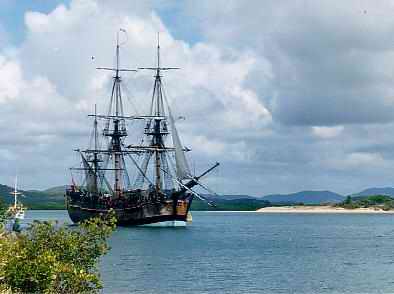
In 1770, James Cook sailed along and mapped the east coast of Australia, which he named New South Wales and claimed for Britain. This led to the establishment of a penal colony there. The transportation of convicts to Australia was phased out between 1840 and 1864.
The British Crown Colony of New South Wales started with the establishment of a settlement at Port Jackson by Captain Arthur Phillip on January 26, 1788. This date was to become Australia's national day, Australia Day.
Van Diemen's Land, now known as Tasmania, was settled in 1803. The United Kingdom formally claimed the western part of Australia in 1829. Separate colonies were created from parts of New South Wales: South Australia in 1836, Victoria in 1851, and Queensland in 1859. The Northern Territory was founded in 1863 as part of the Province of South Australia.
The indigenous Australian population, estimated at about 350,000 at the time of European settlement, declined steeply for 150 years following settlement, because of infectious disease, forced re-settlement and cultural disintegration. The treatment of indigenous people is hotly debated within Australia. After the Australian referendum in 1967, the federal government gained the power to implement policies and make laws with respect to Aborigines. Traditional ownership of land—native title—was not recognized until the High Court of Australia case Mabo v Queensland (No. 2) overturned the notion of Australia as terra nullius at the time of European occupation.
A gold rush began in the early 1850s, and the Eureka Stockade rebellion in 1854 was an early expression of nationalist sentiment. Between 1855 and 1890, the six colonies individually gained responsible government.
On January 1, 1901, the colonies federated and the Commonwealth of Australia was born as a Dominion of the British Empire. The Australian Capital Territory (ACT) was formed in 1911 to provide a location for the federal capital of Canberra (Melbourne was the capital from 1901 to 1927).
Australia willingly participated in World War I in which 59,330 Australians lost their lives. Many Australians regard the defeat of the Australian and New Zealand Army Corps (ANZACs) at the Battle of Gallipoli as the birth of the nation. It was Australia's first major military action. The Kokoda Track Campaign is regarded by many as a nation-defining battle from World War II. A total of 40,400 Australians died in that war. Seventeen thousand served in the Korean War.
The Statute of Westminster (1931) formally ended most constitutional links between Australia and the United Kingdom, but Australia did not adopt the statute until 1942. The shock of the United Kingdom's defeat in Asia in 1942 and the threat of Japanese invasion caused Australia to turn to the United States as a new ally and protector. From 1951, Australia has been a formal military ally of the U.S. under the auspices of the ANZUS treaty. After World War II, Australia encouraged mass immigration from Europe. Beginning in the 1970s and the abolition of a White Australia policy, immigration from Asia and other parts of the world was encouraged. The final constitutional ties between Australia and the United Kingdom ended in 1986 with the passing of the Australia Act 1986, ending judicial appeals to the United Kingdom Privy Council. Australian voters rejected a move to become a republic in 1999 by a 55 percent majority.
Politics
The Commonwealth of Australia is a constitutional monarchy and has a parliamentary system of government. Charles III is the King of Australia, and is represented by the Governor-General of Australia, at federal level, and by the governors at state level.
The parliament, or legislative branch of government, consists of an upper house, or senate, of 76 senators, and a lower house, or House of Representatives, of 150 members. Members of the lower house are elected from single-member constituencies, commonly known as “electorates,” allocated to states on the basis of population. Elections for both chambers are held every three years. The party with majority support in the House of Representatives forms government, with its leader becoming prime minister.
The executive comprises the King, represented by the governor-general, the prime minister, and a cabinet nominated by the Prime Minister.
The judiciary, the third branch of government, consists of the High Court, other federal courts and state courts, all of which became formally independent of the Judicial Committee of the Privy Council in London when the Australia Act was passed in 1986. The legal system is based on English common law.
There are three main political parties: the Australian Labor Party, the Australian Liberal Party and the National Party. Independent members and several minor parties—including the Greens, Family First and the Democrats—have achieved representation mostly in the upper house.
Australia consists of six states: New South Wales, Queensland, South Australia, Tasmania, Victoria, and Western Australia. Two major mainland territories are the Northern Territory and the Australian Capital Territory. The state parliaments control hospitals, education, police, the judiciary, roads, public transport and local government. Each state and territory has its own parliament.
The federal government administers a separate area within New South Wales, the Jervis Bay Territory, as a naval base and sea port for the national capital. External territories include: Norfolk Island, Christmas Island, the Cocos (Keeling) Islands, and the largely uninhabited Ashmore and Cartier Islands, Coral Sea Islands, Heard Island, and McDonald Islands, and the Australian Antarctic Territory.
Australia's foreign relations have been driven by a close association with the United States, through the ANZUS pact and by a desire to develop relationships with Asia and the Pacific, particularly through the Association of Southeast Asian Nations (or ASEAN) and the Pacific Islands Forum. Australia is a member of the Commonwealth of Nations. Much of Australia's diplomatic energy is focused on international trade liberalization. It is a founding member of the United Nations, and extends aid to 60 countries.
Australia's armed forces—the Australian Defence Force—comprise the Royal Australian Navy, the Australian Army, and the Royal Australian Air Force. All branches of the ADF have been involved in UN and regional peacekeeping, most recently in East Timor, the Solomon Islands and Sudan, disaster relief, and armed conflict, including the 2003 invasion of Iraq. The forces, while numerically small compared to some in the region, consist of volunteers and are held in high regard as a well-trained force equipped with modern weapons.
Economy
Australia has a prosperous, Western-style mixed economy, with a per capita gross domestic product (GDP) slightly higher than those of the UK, Germany, and France. In recent years, the Australian economy has been resilient in the face of global economic downturn. Rising output in the domestic economy has been offsetting the global slump, and business and consumer confidence remains robust.
The Australian economy has not suffered a recession since the early 1990s. The service sector, including tourism, education, and financial services, comprises the majority of GDP. Agriculture and natural resources comprise small amounts, but contribute substantially to Australia's export performance.
Australia's largest export markets include Japan, People's Republic of China, the United States, South Korea, and New Zealand. Export commodities include coal, gold, meat, wool, alumina, iron ore, wheat, machinery and transport equipment. Import commodities include machinery and transport equipment, computers and office machines, telecommunication equipment and parts; crude oil and petroleum products. Partners are the U.S., China, Japan, Germany, Singapore, and the United Kingdom.
Demographics
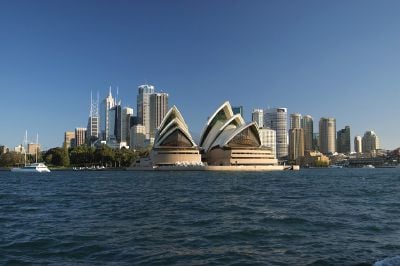
Most Australians are descended from nineteenth and twentieth-century immigrants from Great Britain and Ireland. Australia's population has quadrupled since the end of World War I, spurred by an ambitious immigration program. A policy of multiculturalism has been established to promote racial harmony.
There is a growing self-declared indigenous population—including Torres Strait Islanders, who are of Melanesian descent. Indigenous Australians have higher rates of imprisonment and unemployment, lower levels of education. and shorter life expectancies. Perceived racial inequality is an ongoing political and human rights issue for Australians.
The population is aging, with more retirees and fewer people of working age. A large number of Australians live outside their home country.
English is the official language. Australian English is the only language spoken in the home for around 80 percent of the population. Other languages include Chinese, Italian, and Greek. Many immigrants are bilingual. There were between 200 and 300 Australian Aboriginal languages at the time of first European contact. Only 70 of these languages have survived, and all but 20 are now endangered. An indigenous language remains the main language for a very small minority of people. Australia has a sign language known as Auslan.
Australia has no state religion. Section 116 of the Australian Constitution prohibits the federal government from making any law to establish any religion, impose any religious observance, or prohibit the free exercise of any religion.[11]
School attendance is compulsory between the ages of six and 15 years (16 years in South Australia and Tasmania, and 17 years in Western Australia), contributing to an adult literacy rate of 99 percent. Government grants have helped establish and fund Australia's 38 universities. Several private universities exist. There is a state-based system of vocational training colleges, known as Technical and Further Education Institutes, and trades conduct apprenticeships.
Culture

The culture until the mid-twentieth century was Anglo-Celtic, although distinctive Australian features had been evolving from the environment and Australian Aborigine culture. American popular culture, particularly television and cinema, has had a heavy influence over the past 50 years, as has large-scale immigration from non-English-speaking countries, and Australia's Asian neighbors. The vigor and originality of the arts in Australia—films, opera, music, painting, theater, dance, and crafts—are achieving international recognition.
Australia has a long history of visual arts, starting with the cave and bark paintings of its indigenous peoples. From the time of European settlement, a common theme in Australian art has been its landscape. The traditions of indigenous Australians are transmitted orally. Australian Aboriginal music, dance and Australian Aboriginal art influence contemporary Australian visual and performing arts. Albert Namatjira is a well-known Aboriginal painter. Many ballet and theater companies receive funding through the federal government's Council for the Arts. There is a symphony orchestra in each capital city, and a national opera company, Opera Australia, first made prominent by the renowned diva Dame Joan Sutherland. Australian music includes classical, jazz, and many popular music genres.
Australian literature has also been influenced by the landscape; the works of writers Banjo Paterson and Henry Lawson captured the experience of the Australian bush. The character of colonial Australia, as embodied in early literature, shows an emphasis on egalitarianism, mateship, and anti-authoritarianism. In 1973, Patrick White was awarded the Nobel Prize in Literature, the only Australian to have achieved this.
Australian English is a major variety of the English language. Its grammar and spelling are largely based on those of British English, overlaid with a rich vernacular of unique lexical items and phrases.
Australia has two public broadcasters, the Australian Broadcasting Corporation and the Special Broadcasting Service, three commercial television networks, three pay TV services, and numerous public, non-profit television and radio stations. Australia's film industry has achieved critical and commercial successes, as have quite a number of its actors and actresses. Each major city has daily newspapers, and there are two national daily newspapers, The Australian and The Australian Financial Review.
Sport is important, assisted by a climate that favors outdoor activities; around one fourth of Australians over the age of 15 regularly participate in an organized sport. Australia has particularly strong international teams in cricket, field hockey, netball, rugby league, rugby union, and performs well in cycling and swimming. Other sports include Australian rules football, soccer, and motor racing. Australia has participated in every summer Olympic Games and every Commonwealth Games. Australia has hosted the 1956 Summer Olympics and 2000 Summer Olympics, and has ranked among the top five medal-takers since 2000. Australia has also hosted the 1938 British Empire Games, 1962 British Empire and Commonwealth Games, 1982 Commonwealth Games and 2006 Commonwealth Games. Other major international events held regularly in Australia include the Australian Open, one of the four Grand Slam tennis tournaments, and the Formula One Australian Grand Prix.
Notes
- ↑ Australia also has a royal anthem, "God Save the Queen (or King)," which is played in the presence of a member of the Royal family when they are in Australia. In all other appropriate contexts, the national anthem of Australia, "Advance Australia Fair," is played. See Australian National Anthem Retrieved November 4, 2022; National Library of Australia, Parliamentary Handbook of the Commonwealth of Australia (University of Michigan Library, 2010).
- ↑ Pluralist Nations: Pluralist Language Policies? Global Cultural Diversity Conference Proceedings, Sydney, 1995. Department of Immigration and Citizenship. Retrieved November 4, 2022. "English has no de jure status but it is so entrenched as the common language that it is de facto the official language as well as the national language."
- ↑ Arthur Delbridge, The Macquarie Dictionary (Macquarie Library, 1982, ISBN 978-0949757005).
- ↑ Collins, Collins English Dictionary (Collins, 2011, ISBN 978-0007437863).
- ↑ Population clock Australian Bureau of Statistics. Retrieved November 4, 2022.
- ↑ National, state and territory population Australian Bureau of Statistics. Retrieved November 4, 2022.
- ↑ 7.0 7.1 Report for Selected Countries and Subjects: April 2022 International Monetary Fund, April 2022. Retrieved November 4, 2022.
- ↑ Income Distribution Database Organisation for Economic Co-operation and Development, December 9, 2021. Retrieved November 4, 2022.
- ↑ Human Development Report 2021/2022 United Nations Development Programme, September 8, 2022. Retrieved November 4, 2022.
- ↑ 10.0 10.1 There are minor variations from these three time zones.
- ↑ Commonwealth of Australia Constitution Act - Sect 116 Commonwealth Consolidated Acts. Retrieved November 4, 2022.
ReferencesISBN links support NWE through referral fees
- Collins. Collins English Dictionary. Collins, 2011. ISBN 978-0007437863
- Delbridge, Arthur. The Macquarie Dictionary. Macquarie Library, 1982. ISBN 978-0949757005
- National Library of Australia. Parliamentary Handbook of the Commonwealth of Australia. University of Michigan Library, 2010. ASIN B0041G6I8C
External links
All links retrieved August 22, 2023.
- Australia The World Factbook
- Tourism Australia
- Australian Government
- Australia BBC
| Countries and territories of Oceania | |
| Australia : Australia · Norfolk Island | |
| Melanesia : East Timor · Fiji · Maluku Islands & Western New Guinea (part of Indonesia) · New Caledonia · Papua New Guinea · Solomon Islands · Vanuatu | |
| Micronesia : Guam · Kiribati · Marshall Islands · Northern Mariana Islands · Federated States of Micronesia · Nauru · Palau · Wake Island | |
| Polynesia : American Samoa · Cook Islands · French Polynesia · Hawaii · New Zealand · Niue · Pitcairn Islands · Samoa · Tokelau · Tonga · Tuvalu · Wallis and Futuna | |
Credits
New World Encyclopedia writers and editors rewrote and completed the Wikipedia article in accordance with New World Encyclopedia standards. This article abides by terms of the Creative Commons CC-by-sa 3.0 License (CC-by-sa), which may be used and disseminated with proper attribution. Credit is due under the terms of this license that can reference both the New World Encyclopedia contributors and the selfless volunteer contributors of the Wikimedia Foundation. To cite this article click here for a list of acceptable citing formats.The history of earlier contributions by wikipedians is accessible to researchers here:
The history of this article since it was imported to New World Encyclopedia:
Note: Some restrictions may apply to use of individual images which are separately licensed.



